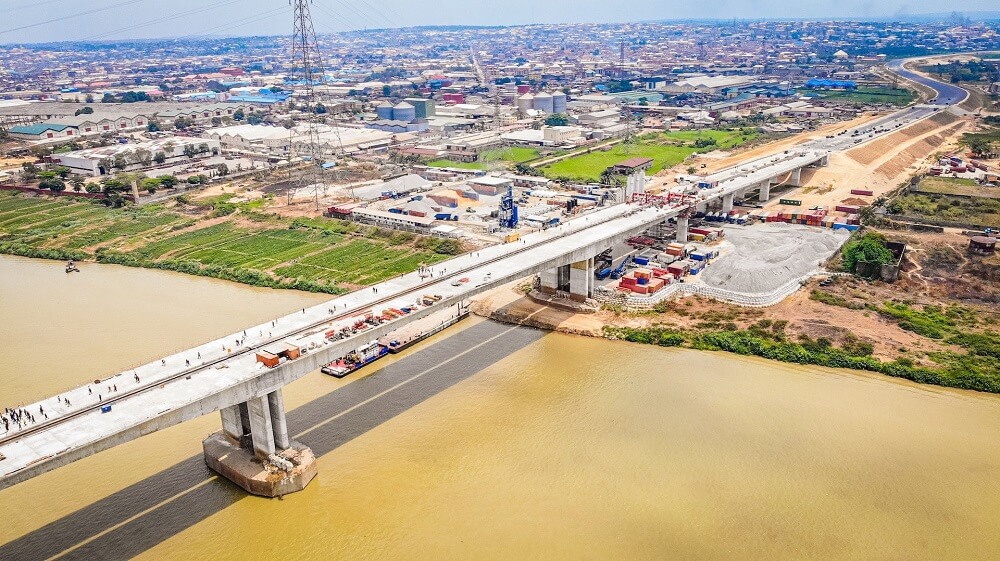When President Muhammadu Buhari on October 8, 2020 made a promise to Nigerians that his administration would complete and commission the Second Niger Bridge before the end of his tenure in 2023, not many people took his promise seriously.
And the reason why many people took the promise made by the President with a pinch of salt is not far-fetched.
Let’s delve a little into history. The Second Niger Bridge was first proposed during the 1968/69 political campaign by the National Party of Nigeria.
In 1987, after warning about the state of the existing River Niger Bridge by the then Minister for Works and Housing Abubakar Umar, General Ibrahim Babangida challenged the local engineers to design the Second Niger Bridge.
The local engineers rose to the challenge and through the Nigerian Society of Engineers subsequently delivered a masterplan. Unfortunately, the turmoil that precipitated the end of Babangida’s administration in 1993 stalled the plan.
Under the subsequent military governments, the project received little attention. Upon the return to civilian rule on May 29, 1999, President Olusegun Obasanjo promised to deliver a second Niger River bridge.
However, Obasanjo’s administration did not carry out any major activity on the project until five days before he handed over in 2007 to the administration of Umaru Musa Yar’ Adua. That was when he flagged off the project in Asaba in Delta State.
The handing over of the project by Obasanjo to Yar’ Adua made his administration to effectively inherit a ₦58.6bn proposed cost for a six lane, 1.8 km tolled bridge, which was to be completed in three-and-half years.
Based on the funding structure then, the bridge was to be financed under a public private partnership (PPP) with 60 per cent of the funding coming from the contractor, Gitto Group; 20 per cent from the federal government and 10 per cent from the Anambra and Delta State Governments.
Unfortunately, the subsequent death of Yar’ Adua on May 5, 2010 marred the progress of the project. However, in August 2012, the Federal Executive Council under the administration of Goodluck Jonathan, approved a contract worth ₦325m for the final planning and design of the bridge.
Before then, during the 2011 general election in Nigeria, Jonathan had while campaigning for office of the President promised that if elected, he would deliver the project before the end of his term in 2015.
At an Onitsha town hall meeting on August 30, 2012, Jonathan had sworn to go into exile if he did not deliver on the project by 2015.
The act of rigmarole where the Second Niger bridge was used as a major political pawn continued until Buhari first cancelled the earlier contract in August 2015.
The project was subsequently awarded to Julius Berger for a contract sum of N206bn, to be implemented by the Nigerian Sovereign Investment Authority with funding from the Presidential Infrastructure Development Fund.
The second Niger bridge is one of the three projects being funded from the Presidential Infrastructure Development Fund. The other two projects are the Abuja-Kaduna-Kano Road project and the Lagos-Ibadan express road project.
The PIDF is a special fund set up by President Muhammadu Buhari and managed by the NSIA. The NSIA brought some of its own capital, the capital provided by the federal government and the fund return to Nigeria as Abacha loot.
One of the objectives of the bridge is to minimize traffic congestion on the old Niger bridge and to strengthen connectivity in the entire South-East region.
Under the new arrangement, the scope of work was expanded to involve the construction of a 1.6km bridge over the River Niger, scheduled for completion in August 2022, construction of two secondary bridges at CH25+166 (Amakom Village Road) and CH28+304 (Atani Road) spanning 21.7m each, which have now been completed, demolition of existing flyover and construction of new interchange at CH34+100 (Onitsha-Owerri Road), scheduled for completion in August 2022.
The project also involves the construction of 3.3km Approach road on the Asaba side and 7.0km approach road on the Onitsha side of the main bridge, scheduled for completion in October 2022, toll plaza at CH25+700 which consists of eight lanes in each direction, scheduled for completion in October 2022, and site clearing of the Right of Way (RoW) including the removal of all bush, trees and shrubs.
The construction work for the project also involves soil improvement including soil exchange, geo-textile as a filter layer, geo-textile for base reinforcement, pre-fabricated vertical drains, geo-textile encased sand columns and geo-textile for base reinforcement.
Upon completion, the project will offer significant socio-economic benefits for the contiguous states and indeed the entire nation by easing traffic flow, improving road safety, and creating greater opportunities for residents and neighboring states, thereby regenerating economic life.
The Approach Roads will drive traffic to the bridge via two 17.5km Approach roads on either side of the bridge and enhance the project’s viability.
The first visit to the project site within the last one month was by President Muhammadu Buhari who was represented by his Chief of Staff, Prof Ibrahim Gambari.
He was accompanied on the inspection by the Minister of Works, Babatunde Fashola; Minister of Labour and Employment, Dr Chris Ngige; the Managing Director of the Nigerian Sovereign Investment Authority, Uche Orji; and other top officials of government.
During that visit, Fashola had stated that contrary to what people claimed two years ago that there was no bridge, the fast pace of work on the site against all odds had shown otherwise.
“What I said was the bridge link will be completed around February or at the latest the end of the first quarter.
“We are now heading towards the end of the first quarter and as you have heard from them, they will complete the east bound link on the 15th of March and the west bound link on the 2nd of April,” he had said.
True to Fashola’s prediction, the linking of the Second Niger bridge was done on April 2 in the presence of the Minister of Finance, Budget and National Planning, Mrs Zainab Ahmed; the Chairman, Board of Directors of the NSIA, Mr Farouk Gumel, the NSIA Managing Director, Uche Orji; and the Deputy Governor of Anambra State Gilbert Ibezim during a tour of the project site.
Ahmed, who was visibly excited when she saw the architectural masterpiece of the bridge commended the NSIA and Julius Berger on the pace, and quality of job so far done on the project.
The bridge has been linked, all engineering works completed and the only thing that is left for the project is just the finishing.
The Minister said, “Today is a very significant day in the construction cycle of the second Niger bridge. This is one of the most iconic projects in the country costed at an initial contract cost of N206bn.
“Today, we have been able to fund this project with N157bn and I’m here to see where all this money is going to. And also, the significance of today is that the two ends of the bridge are being put together and this is the final phase of the work in truly competing the project and the finishing work of the bridge.
“So technically, I can report to Mr. President that I have seen where all the N157bn has gone to. This is a project that is very dear to the President and it is designed to uplift the lives and livelihood of the people of the South-East and other parts of the country.
“And we do hope that when this project comes on stream, it will ease traffic, will enhance commercial activities and improve the lives of the people of the state.
Even without it being commissioned, the developmental impact of the project is being felt as over 20,000 jobs have so far been created for Nigerians living in the states within the bridge.
The Finance Minister alluded to this fact when she said, “I am happy to see the ladies I am seeing at the construction site, not all men. Julius Berger has brough some very unique innovations in the construction of this project and I want to on behalf of the government and people of Nigeria applaud the skills of the construction workers that have been working on this site.”
One thing that was also a source of concern during the initial stage of the implementation of the project was the issue of compensation.
But this is no longer a challenge as significant number of the settlements that were affected by the project had been adequately compensated.
The NSIA MD gave credence to this during the inspection tour when he said, “Regarding compensation, this is an ongoing affair, we ‘ve paid significant sums earlier and there are still some more compensations to be made to some areas as we continue work.
“As you can see, the bridge itself is 11.9 kilometers, there is still 17 kilometers of road on this side and the Asaba end of the road that will be paid.
“Assessment is still being made for compensation but I can assure you is that the directive we have from the president and from the minister and our board is that adequate compensation is paid to everyone who is affected.”
With the infrastructure project at an overall completion rate of 84 per cent, and a 91 per cent completion rate for the bridge portion, it is clear that the delivery of the project by the contractors and its eventual commissioning before the end of this year by the Buhari is a done deal.
Onuba, a Chartered Accountant wrote in from Abuja
 DailyrecordNg …Nigeria's hottest news blog
DailyrecordNg …Nigeria's hottest news blog









